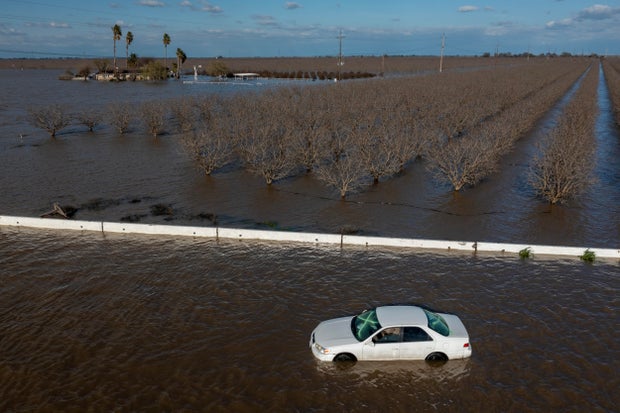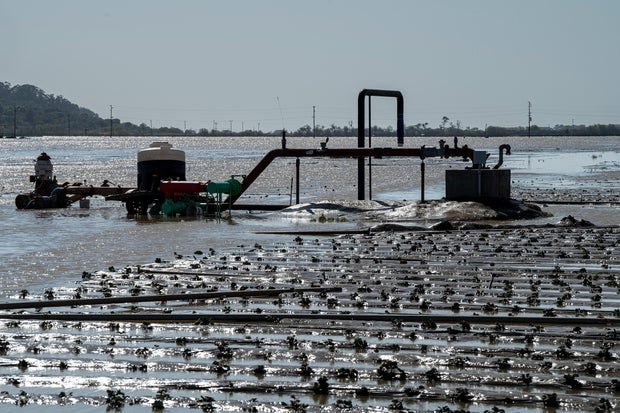Why you’ll probably be paying more for produce this season
Thanks to devastating storms in California this winter, shoppers everywhere will be paying higher prices on groceries this spring and summer.
At least 16 atmospheric rivers unloaded torrential rain and wind on California between December and March, flooding the state’s growing region and affecting strawberries, lettuce, broccoli, cherries, tomatoes and more.
It is illegal in California to harvest flooded farmland because floodwaters can bring dangerous bacteria or contamination — as a result, some farmers have to abandon their crops. Less produce to harvest will drive prices up in late spring and summer, and possibly for the rest of the year, Sreedevi Rajagopalan, a postdoctoral researcher studying supply chains at MIT, told CBS News.
“For the farmers, this catastrophe hit at the worst possible time,” Rajagopalan said.
In the fall and winter, buyers across the country depend on crops grown in warmer climates such as Southern California, Arizona and Mexico. But as those regions get hotter in the spring and summer, Northern California begins to dominate the produce market, making April critical to the nation’s produce supply.
What is an “atmospheric river” and why is it affecting America’s food supply?
These narrow systems carry heavy precipitation from the tropics to America’s West Coast an average five to six times a year and, on average, inflict $1.1 billion in damage annually. California farmers rely on the storms to counterbalance drought and replenish the state’s water supply. But this winter’s extreme stretch of storms left tens of thousands of acres of California farmland flooded — land that helps support a $50 billion state industry that employs more than 420,000 people.
David McNew / Getty Images
What will you be paying more for?
Prices are likely headed up for broccoli, cauliflower, celery and lettuces — all from the “world’s salad bowl,” the Salinas Valley, which is responsible for 80% of all the vegetables grown in the country between April and July.
Also expect to pay more for items like tomato sauce and frozen pizzas — anything with processed tomatoes, which often come from California’s Central Valley.
Daniel Sumner, the director of the University of California Agricultural Issues Lab, said that processed tomato prices have already been high thanks to global supply issues and record drought in California. Farmers in the Central Valley planted more acres of tomatoes this year to catch up, Sumner said, making the winter storms’ damage all the more devastating.
“It’s maybe 10% of the acreage, but 10% is a lot — and it’s enough to affect the price,” said Sumner.
The rain and wind kept farmers of California’s orchard crops — think cherries, nectarines, almonds and walnuts — from planting and bees from pollinating, which will likely mean less to harvest and higher prices.
David Paul Morris/Bloomberg via Getty Images
Farmers and agricultural workers are feeling the squeeze
“There’s going to be a lot of delayed harvesting that happens this year,” said Linda Luka, director of marketing and communications at General Produce, a Sacramento-based distributor that provides food to more than 1,500 clients in Northern and Central California, southern Oregon and western Nevada — including stores and schools, restaurants, prisons and more.
Their trucks can’t even get to some clients, as flooding and power outages made some roads and bridges in the region impassable.
California cherries, for example, will now be harvested four to five weeks later than usual, Luka said. And that not only drives up prices for consumers, but financially hurts the people who normally would harvest the crops.
“Unlike a lot of other industries, [agriculture] is entirely constrained by time. It’s not like a factory where if you’re off a few weeks you can just come back and unlock the factory and go back to work,” said Evan Wiig, director of membership and communications for the Community Alliance with Family Farmers, a California-based nonprofit.
How climate change is driving “precipitation whiplash”
The rapid transition between terrible drought and flooding in the state is known as “precipitation whiplash.” Atmospheric rivers — which are notoriously hard to predict and prepare for — are expected to become more common and more severe in the coming years as global temperatures rise.
Wiig said that while the excess rain is welcomed after three years of historic drought in California, the threat of extreme weather becoming more severe looms in every farmer’s mind.
“California has always been an ecology of extremes. We’ve always been a place of fire and flood and drought,” said Wiig. “But it’s just been exacerbated over the last several years and it’s really starting to take its toll.”
For all the latest Automobiles News Click Here
For the latest news and updates, follow us on Google News.



